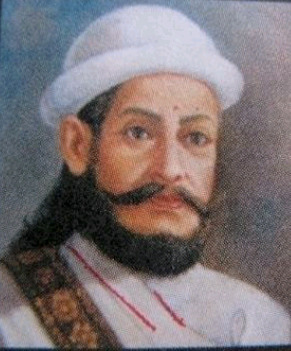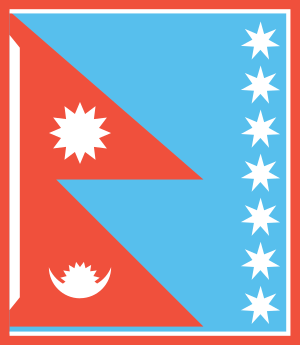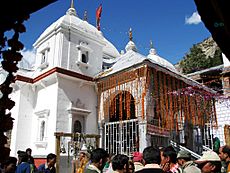Amar Singh Thapa facts for kids
Quick facts for kids
Sri Bada Kaji Jarnel
Amar Singh Thapa Chhetri
|
|
|---|---|
| श्री बडाकाजी जर्नेल अमर सिंह थापा क्षेत्री |
|

Portrait of Bada (Elder) Amar Singh Thapa Chhetri
|
|
| Personal details | |
| Born | 1751 A.D. (1808 B.S.) Sirhanchowk, Gorkha District |
| Died | 1816 A.D. Gosain Kunda, Rasuwa District |
| Relations | see Family of Amar Singh Thapa see Kunwar family |
| Parents |
|
| Awards | National heroes of Nepal (posthumous) |
| Signature |  |
| Nicknames | Living Lion of Nepal Bada Kaji Budha Kaji |
| Military service | |
| Allegiance | Gorkha Kingdom, |
| Branch/service | Nepalese Army |
| Rank | General |
| Commands | Supreme Commander of Western front |
| Battles/wars | Anglo-Nepalese war, Battles of unification of Nepal, reinforced at 2nd Nepalese-Tibetan War |
Amar Singh Thapa Chhetri was a very important military general in the Kingdom of Nepal. People knew him as Bada Kaji Amar Singh Thapa or Amar Singh Thapa The Elder. He was also called "Bada Kaji" (Senior Kaji) or "Budha Kaji" (The Old Kaji).
He was the main commander of the Nepal Army during the time Nepal expanded its territory to the west. He also ruled the Kumaon and Garhwal areas. The King of Nepal even made him like a Prime Minister (called Mukhtiyar) for these western regions. He is often called the Living Lion of Nepal because he was so brave. After he died, he was recognized as one of the national heroes of Nepal. He led the Gorkhali Army during the Anglo-Nepalese War. Places like Amarsingh Chowk in Pokhara and Shree Amarsingh Model Higher Secondary School are named after him.
Contents
Early Life and Family

Amar Singh Thapa was the grandson of Ranjai and the son of Bhim Sen. His father, known as Bagh Bhim Singh Thapa, was a brave commander who died in battle in 1759 AD. Amar Singh belonged to the Bagale Thapa family.
He was called "Amar Singh Thapa (Bada)" to tell him apart from another Kaji named Amar Singh Thapa (Sana). "Bada" means elder, and "Sana" means younger. Many of his family members became important in the Royal Court. His eldest son, Ranadhoj Thapa, was a deputy to the Prime Minister, Bhimsen Thapa. His other sons, Bhaktabir Singh, Narsingh, Ramdas, and Ranajor Singh Thapa, also became Kajis.
His youngest son, Ranajor Singh Thapa, fought alongside him in the Anglo-Nepalese War. His grandsons, Ripu Mardan and Badal Singh, also became Kajis. This shows that his family was very influential in the Royal Court, just like the family of Prime Minister Bhimsen Thapa.
Conquering New Lands
Bada Amar Singh led many battles to conquer western areas as Nepal grew bigger. He was leading the fight for Langur Gadhi in the Gadhwal Region. This was just before the second Sino-Nepalese War (1791–92 A.D.). He quickly returned to Nuwakot, traveling about 1000 km in a month, to help defend Nepal.
In 1804, he helped take over the Butwal plains. He also made sure that the Palpa region continued its agreements with the King of Gorkha. After 1806, he and Kaji Dalbhanjan Pande were in charge of Palpa. They made plans to fully control these lands by appointing officials and managing land. They also stopped giving rent-free land to some priests to pay the Gorkhali soldiers.
In 1804, Amar Singh led the Gorkhali Army with Sardar Bhakti Thapa and Hasti Dal Shah. They fought against the Garhwal Kingdom because Garhwal stopped its yearly payments to Nepal. The army won, and Garhwal became part of Nepal. This made Nepal's territory reach the Sutlej river in the west.
Bada Amar then led his troops to the Kangra fort of King Sansar Chand. They captured the fort. King Sansar Chand got help from 1500 soldiers of Sikh Maharaja Ranjit Singh. They fought against Amar Singh's forces. The Gorkhali Army lost some ground and Amar Singh had to return to the Sutlej river in 1809. The Gorkhas were proud warriors, but they faced stronger, more modern Sikh forces.
Amar Singh Thapa advised the Chief Authority of Nepal, Bhimsen Thapa, not to go to war with the British. He knew how hard wars were from his own experience. He was one of the senior leaders who did not want the Anglo-Nepalese War. He thought the western areas, which were newly conquered, might revolt because the administration there was weak.
Anglo-Nepalese War
When the British asked Nepali chiefs what they thought about a possible war, Amar Singh Thapa was against it. He believed the war started because some people were greedy and wanted to gain personal wealth.
First Campaign
In the first part of the Anglo-Nepalese War, Bada Amar Singh led the Nepali army. He faced British Generals Rollo Gillespie and David Ochterlony in the western front.
He commanded the Gorkhali forces to defend the town of Srinagar. His son, Ranjore Singh Thapa, was holding forces at Nahan.
Second Campaign
In the second part of the war, Amar Singh was in charge of the Sindhuli Gadhi area. His forces faced many attacks from British Colonels Kelly and O'Hollorah. His son Ranjore also came to Sindhuli Gadhi to help defend the fort. The British could not reach Sindhuli Gadhi and had to retreat.
Buildings and Legacy
Amar Singh was a religious person who built many forts and temples in Nepal and India. He built the original Gangotri Temple in Uttarakhand, which is a famous pilgrimage site. He also built the Sri Ram Temple in Janakpur, Nepal, which is one of the oldest temples there. After Nepal took full control of Palpa, he built the Amar Narayan temple in Tansen in 1807.
Bada Kaji Amar Singh is often called the Living Lion of Nepal. This is because he was a great fighter, a strong leader, and very patriotic. A British historian named Hamilton even compared him to the ancient Carthaginian General Hannibal.
The village of Amaragadhi in western Nepal is named after him. There is also a special Khukuri sword named the Amar Singh Thapa Khukuri. This Khukuri is designed like the one he actually used. His real Khukuri is kept at the National Museum of Nepal.
Descendants
Amar Singh had many children. Historian Surya Bikram Gyawali says he had 9 sons, all of whom helped in the unification of Nepal. Other records show he had ten sons from four wives. These included Ranadhoj, Ranajor, Bhaktabir, Ramdas, and Narsingh, who all became Kajis.
His grandsons through his daughter Ambika Devi were Birbhadra Kunwar and Balabhadra Kunwar. Balabhadra Kunwar is a national hero famous for his bravery in the Battle of Nalapani.
Today, Nepali movie director Sunil Thapa is a descendant of Bada Kaji Amar Singh. His daughter, actress Suhana Thapa, is also a descendant.
Gallery






